中西方商务餐桌礼仪文化分析英语
中西方餐桌礼仪文化差异英语作文
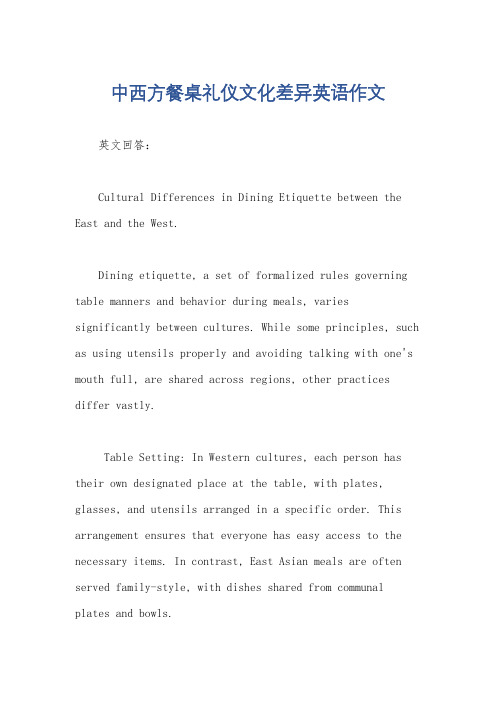
中西方餐桌礼仪文化差异英语作文英文回答:Cultural Differences in Dining Etiquette between the East and the West.Dining etiquette, a set of formalized rules governing table manners and behavior during meals, variessignificantly between cultures. While some principles, such as using utensils properly and avoiding talking with one's mouth full, are shared across regions, other practices differ vastly.Table Setting: In Western cultures, each person has their own designated place at the table, with plates, glasses, and utensils arranged in a specific order. This arrangement ensures that everyone has easy access to the necessary items. In contrast, East Asian meals are often served family-style, with dishes shared from communal plates and bowls.Meal Sequence: In the West, meals typically adhere toa set sequence: appetizer, soup, salad, entree, and dessert. It is considered polite to wait until everyone at the table has finished a course before proceeding to the next. InEast Asian cultures, however, the meal begins with a rangeof dishes that are enjoyed simultaneously and there is no predetermined order.Tableware Usage: Westerners primarily use knives, forks, and spoons for eating, while East Asians typically use chopsticks. In some East Asian cultures, spoons arealso used for soups and broths. The handling of these utensils differs as well; in the West, forks are held inthe left hand and knives in the right, while in East Asia, chopsticks are held in the dominant hand and used to convey food to the mouth.Conversation and Communication: During meals in the West, conversations are typically light and engaging, butit is considered impolite to speak with one's mouth full or to discuss controversial topics. In East Asian cultures,mealtimes are often used for more serious conversations and discussions.Table Manners: In the West, it is considered polite to sit up straight, not to reach across the table, and to fold one's napkin on the table when leaving. In some East Asian cultures, it is customary to slurp noodles or soup to show appreciation for the meal, while in the West, such behavior is considered rude.These are just a few of the many differences in dining etiquette between Eastern and Western cultures. Understanding these variations is essential for respectful and enjoyable dining experiences across borders.中文回答:东西方餐桌礼仪文化差异。
中西方餐桌礼仪作文英语

中西方餐桌礼仪作文英语Paragraph 1:在中国,餐桌礼仪被视为个人修养和尊重他人的体现。
"食不言,寝不语"的传统观念强调了用餐时的庄重与静谧。
餐前,长辈先动筷子被视为尊敬;共享菜肴时,使用公共筷子或公勺以示卫生与礼节;同时,为主人或客人夹菜更是对对方热情好客的表现。
In China, table manners are viewed as an embodiment of personal cultivation and respect for others. The traditional concept of "not talking while eating, not speaking while sleeping" emphasizes solemnity and quietness during meals. Before the meal, it is a sign of respect for elders to start eating first; when sharing dishes, using serving chopsticks or spoons demonstrates hygiene and etiquette; moreover, offering food to hosts or guests by personally picking up dishes with chopsticks is a demonstration of warm hospitality.Paragraph 2:而在西方国家,餐桌礼仪同样体现了对他人的尊重以及社会规范的理解。
在餐桌上,"等所有人就座后再开始用餐"的原则彰显了公平与耐心。
刀叉的使用遵循“由外至内”的规则,以展示良好的教养和有序的用餐过程。
此外,将食物放入口中时应避免发出声音,咀嚼食物需闭嘴,这都是西方餐桌文化中的基本礼节。
中西方餐桌礼仪英语作文

中西方餐桌礼仪英语作文Table Manners in China and the West: A Comparative EssayIn the realm of cultural differences, dining etiquette stands out as a significant aspect that varies greatly between the East and the West. This essay aims to explore and compare the table manners prevalent in China and Western countries, highlighting the nuances that make each culture unique.In China, dining is not merely about consuming food; it is a social event that reflects the host's generosity and the guests' respect. The host often takes the seat facing the door, a position of honor, and guests are seated according to their social status or age. It is customary for the host to pour drinks and offer food to the guests before starting the meal. The use of chopsticks is an art form in itself, with a set of rules that must be followed. For instance, it is considered impolite to stick chopsticks vertically into a bowl of rice, as this resembles incense sticks used in ancestor worship and funerals.On the other hand, Western dining etiquette is characterized by a more individualistic approach. The use of cutlery is a fundamental part of the dining experience. Typically, a knife and fork are placed at the side of the plate, with the fork on the left and the knife on the right. It is important to note that the fork is used in the left hand to hold the food, while the knife in the right hand is used for cutting. Whenfinished eating, the utensils are placed together on the plate with the handles to the right, indicating to the server that the meal is complete.Another notable difference is the concept of sharing food. In Chinese dining, it is common to have a variety of dishes placed in the center of the table for everyone to share. This communal style of eating is a way to foster a sense of community and togetherness. In contrast, Western dining often involves individual plates with a set menu for each person, although sharing plates are becoming more popular in contemporary dining.Toasting is an important part of both Chinese and Western meals, but the manner of toasting can differ. In China, the host usually initiates the first toast, and it is polite for guests to keep their glasses lower than the host's when clinking glasses to show respect. In the West, toasts are often made by guests and can be more spontaneous, with a simple raise of the glass and a verbal toast being the norm.The concept of tipping is also a significant difference between the two cultures. In China, tipping is not customary and can sometimes be seen as an insult, as it may imply that service was not satisfactory. In Western countries, however, tipping is an expected practice and a way to show appreciation for good service, typically ranging from 10% to 20% of the total bill.In conclusion, the art of dining is a rich tapestry woven with the threads of cultural heritage and social norms.Understanding and respecting these differences is not only a sign of cultural sensitivity but also a way to enhance the dining experience. Whether you are using chopsticks in China or a knife and fork in the West, the key to enjoying a meal is to appreciate the local customs and engage in the social aspect that makes dining a truly global pleasure.。
中西方餐桌礼仪的差异英语作文
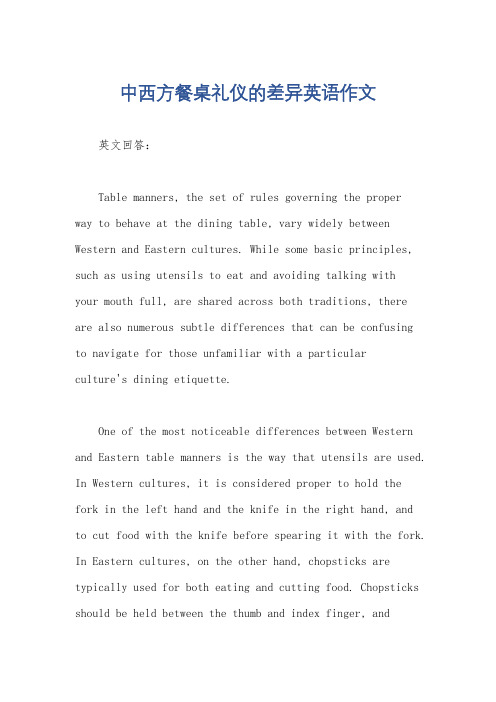
中西方餐桌礼仪的差异英语作文英文回答:Table manners, the set of rules governing the properway to behave at the dining table, vary widely between Western and Eastern cultures. While some basic principles, such as using utensils to eat and avoiding talking withyour mouth full, are shared across both traditions, there are also numerous subtle differences that can be confusingto navigate for those unfamiliar with a particularculture's dining etiquette.One of the most noticeable differences between Western and Eastern table manners is the way that utensils are used. In Western cultures, it is considered proper to hold thefork in the left hand and the knife in the right hand, andto cut food with the knife before spearing it with the fork. In Eastern cultures, on the other hand, chopsticks are typically used for both eating and cutting food. Chopsticks should be held between the thumb and index finger, andshould not be crossed over each other.Another difference between Western and Eastern table manners is the way that rice is eaten. In Western cultures, it is considered acceptable to use a fork to eat rice, while in Eastern cultures, rice is typically eaten with chopsticks. When eating rice with chopsticks, it is important to hold the bowl close to your mouth and to scoop the rice into your mouth with the chopsticks.There are also differences between Western and Eastern table manners with regard to the way that food is shared. In Western cultures, it is considered acceptable to share food by passing dishes around the table. In Eastern cultures, on the other hand, it is considered more polite to serve individual portions of food to each guest.Finally, there are differences between Western and Eastern table manners with regard to the way that the table is set. In Western cultures, it is customary to set the table with a plate, a fork, a knife, a spoon, and a glass. In Eastern cultures, on the other hand, the table istypically set with a bowl, a pair of chopsticks, a spoon, and a teacup.These are just a few of the many differences between Western and Eastern table manners. By understanding these differences, you can avoid making any embarrassing faux pas the next time you dine with someone from a different culture.中文回答:餐桌礼仪的差异。
介绍中国与西方餐桌文化英语作文
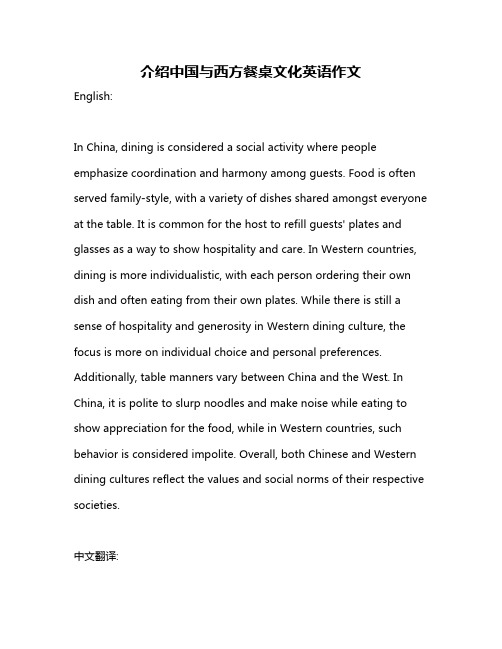
介绍中国与西方餐桌文化英语作文English:In China, dining is considered a social activity where people emphasize coordination and harmony among guests. Food is often served family-style, with a variety of dishes shared amongst everyone at the table. It is common for the host to refill guests' plates and glasses as a way to show hospitality and care. In Western countries, dining is more individualistic, with each person ordering their own dish and often eating from their own plates. While there is still a sense of hospitality and generosity in Western dining culture, the focus is more on individual choice and personal preferences. Additionally, table manners vary between China and the West. In China, it is polite to slurp noodles and make noise while eating to show appreciation for the food, while in Western countries, such behavior is considered impolite. Overall, both Chinese and Western dining cultures reflect the values and social norms of their respective societies.中文翻译:在中国,用餐被视为一种社交活动,人们强调客人之间的协调和和谐。
中西方餐桌礼仪的差异-商务英语-毕业论文文档
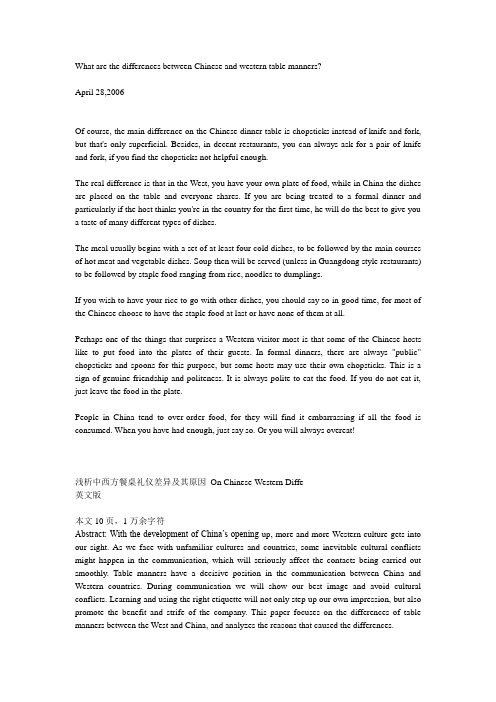
What are the differences between Chinese and western table manners?April 28,2006Of course, the main difference on the Chinese dinner table is chopsticks instead of knife and fork, but that's only superficial. Besides, in decent restaurants, you can always ask for a pair of knife and fork, if you find the chopsticks not helpful enough.The real difference is that in the West, you have your own plate of food, while in China the dishes are placed on the table and everyone shares. If you are being treated to a formal dinner and particularly if the host thinks you're in the country for the first time, he will do the best to give you a taste of many different types of dishes.The meal usually begins with a set of at least four cold dishes, to be followed by the main courses of hot meat and vegetable dishes. Soup then will be served (unless in Guangdong style restaurants) to be followed by staple food ranging from rice, noodles to dumplings.If you wish to have your rice to go with other dishes, you should say so in good time, for most of the Chinese choose to have the staple food at last or have none of them at all.Perhaps one of the things that surprises a Western visitor most is that some of the Chinese hosts like to put food into the plates of their guests. In formal dinners, there are always "public" chopsticks and spoons for this purpose, but some hosts may use their own chopsticks. This is a sign of genuine friendship and politeness. It is always polite to eat the food. If you do not eat it, just leave the food in the plate.People in China tend to over-order food, for they will find it embarrassing if all the food is consumed. When you have had enough, just say so. Or you will always overeat!浅析中西方餐桌礼仪差异及其原因On Chinese-Western Diffe英文版本文10页,1万余字符Abstract: With the development of China’s opening-up, more and more Western culture gets into our sight. As we face with unfamiliar cultures and countries, some inevitable cultural conflicts might happen in the communication, which will seriously affect the contacts being carried out smoothly. Table manners have a decisive position in the communication between China and Western countries. During communication we will show our best image and avoid cultural conflicts. Learning and using the right etiquette will not only step up our own impression, but also promote the benefit and strife of the company. This paper focuses on the differences of table manners between the West and China, and analyzes the reasons that caused the differences.Key words: etiquette,table manner,difference,culture,reason关键词:礼仪餐桌礼仪差异文化原因On Chinese-Western Differencesin Table MannersⅠ. The importance of table manners in international communicationWith the development of opening-up policy, foreign etiquette enters to our daily life day by day. Besides the commercial etiquette, the dinner table etiquette is very important, too. As there are many different cultures between China and Western countries, we have different dinner.....Outline:Ⅰ.The importance of table manners in international communicationⅡ.The Specific of table mannersA 、arrival of timeB、the concept of dishesC、the atmosphere on tableD、seat arrangementE、customary action on tableⅢ. The causes of different dining customs between the West and ChinaA、different time conceptsB、different ideasC、different behaviors regulationⅣ. ConclusionsBibliography:1.顾江禾,东西方文化对比小议《太原重型机械学院学报》,2001年第22卷第4期,279-2822.华厚坤,试论跨文化语境下的大学英语教学《黑龙江高教研究》,2003年第6期,153-1543.吴锋针,中西习俗文化“冲突”《绥化师专学报》,2003年第1期,90-92“中西方饮食文化差异”以及“中西方餐桌礼仪的区别”一)基本的讲究排列座次时,国内外的基本作法有所不同。
中西方的餐桌礼仪英文作文

中西方的餐桌礼仪英文作文英文:When it comes to table manners, there are some key differences between Western and Chinese cultures. In the West, it is considered polite to place your napkin on your lap as soon as you sit down at the table. It is also customary to keep your hands visible and not to rest your elbows on the table while eating. In addition, it is important to chew with your mouth closed and to avoid talking with food in your mouth.On the other hand, Chinese table manners are quite different. In China, it is common to use chopsticks instead of utensils, and it is considered polite to hold the rice bowl close to your mouth while eating. It is also acceptable to make some noise while eating, such asslurping noodles, as it shows that you are enjoying the meal.In terms of seating arrangements, Western culture typically follows a more formal approach, with assigned seats and a specific order for serving food. In Chinese culture, seating arrangements are often more flexible, andit is common for dishes to be placed in the center of the table for everyone to share.Overall, understanding and respecting these differences in table manners is important when dining with people from different cultures. By being aware of these customs, we can show respect and consideration for our dining companions.中文:在餐桌礼仪方面,中西方文化之间有一些关键的差异。
英语课件中西方餐桌礼仪_演示文稿概要
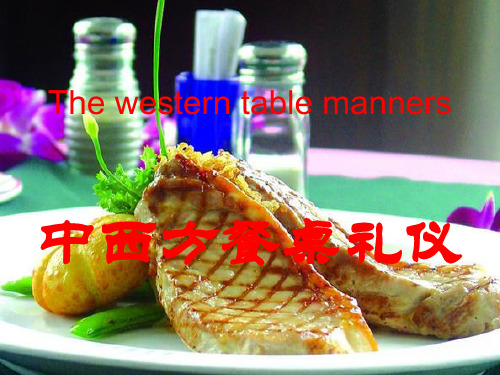
上菜顺序
• In China • The soup, vegetab les • The staple food • The wine • The fruit
中方①汤、菜②主食③餐酒④水果
• West of vegetable of fruit and wine the staple food, the Dessert Cafe • 西方 ①菜 ②水果 ③餐酒 ④主食 ⑤甜点 、咖啡
Seating position入座的位置
中方餐具
• China tableware cups, plates, bowls, main dishes, spoons, chopstickห้องสมุดไป่ตู้, and so on several.
• 中方餐具主要 有杯子、盘子、 碗、碟子、筷 子、匙羹等几 种。
西方餐具
西方餐具主要包括刀、叉、匙、 盘、杯等。 刀又分为食用刀、鱼刀、肉刀、 奶油刀、水果刀;叉又分为食 用叉、鱼叉、龙虾叉;公用刀 叉的规格一般大于使用刀叉。 匙又分汤匙、茶匙等; 杯的种类更多,茶杯、咖啡杯 为 瓷器,并配小碟;水杯, 酒杯多为玻璃制品。
Western tableware mainly comprises a knife, fork, spoon, plate, cup. The knife was divided into edible knife, knife, sword fish meat, butter knife, fruit knife; fork is divided into edible fork, harpoon, lobster fork; utility knife and fork specification is generally greater than the use of a knife and fork. Tablespoon, teaspoon, spoon divides; Cup type are more, tea cup, coffee cup and saucer; for porcelain, glass, glass for glass products.
- 1、下载文档前请自行甄别文档内容的完整性,平台不提供额外的编辑、内容补充、找答案等附加服务。
- 2、"仅部分预览"的文档,不可在线预览部分如存在完整性等问题,可反馈申请退款(可完整预览的文档不适用该条件!)。
- 3、如文档侵犯您的权益,请联系客服反馈,我们会尽快为您处理(人工客服工作时间:9:00-18:30)。
The Analysis of China and Western Table MannersForewordWith the rapid development of economic globalization, the culture between China and Western has also been a very good development and integration.According to the literature, the manners of Zhou Dynasty, has formed a well-established system. The table manners played a very important role in the life of modern Chinese people. Dining not only meets the physical needs, but also an important social etiquette, and it also embodies a person’s upbringing and quality.The banquet in western countries, from the formal to the informal, is far more than China. The table manners of western countries have a lot of forms, expect this, the degree of formality also has a big difference. Generally, there are seated dinners, buffet dinners, luncheons, receptions, cocktail parties, BYOB and BYOF (Bring your own bottles and bring your own food), picnics, tea parties, and so on.1.The summarize of china and western countries table mannersThe Chinese dining etiquette has a long history. According to the literature show that, at least in Zhou Dynasty, the eating etiquette has formed a well-established system. Especially that, the Confucius, as the libation of State of Lu, has praised and respected the eating etiquette, so, it become an important aspect of dynasties performance of major powers of landscape, ceremonies and civilization.As Han traditional ancient feast etiquette, it has own program: the host invites guest with writing a letter and he/she will go to meet the guests at the door personally. When the guests arrived, they will greet each other. Than, the host brings the people into the living room to sit and entertains the guests with refreshments. After the guests in attendance, we can take a seat. Generally, where a guest is seated depend on his age, social status and so on. “Taking the left for upper”, it is the traditional custom in China. It means the left seat is higher than the right one. The guest of honor should be arranged on the left of host. Chinese entertained guest using the Eight-Immortal table in tradition. The seat faced to the door is the seat of honor, while the others are seated aside. The older, the guest of honor, the high-level isseated in the upper seat, and the hosts sit at the lower seat. When there is more than one table, the host and hostess seat together in the main table. The distance from one table determined the position of these people.Western table manners originated in the French Merovingian. Inspired by Byzantine Culture, so, the manners develop a series of subtlety etiquette. To the Roman Empire of Charlemagne, the etiquette is more complex and tyranny. The emperor must sit the highest chair. Whenever the music sounded, the nobility must spread the dishes to the emperor’s hands. Before the 17th century, it is a traditional habit for people to wear a hat when dining. In the Imperial era, table manners seem tedious and demanding, different ethnic groups have different eating habits, for example, Gauls sit to dinner, Romans lying to eat, the French are taught from childhood that meal with both hands on the table, but Englishman was taught that put you hands on your tights when you don not eat. The European table manners developed from the chivalry. In 12th century, when the culture of Italian has influenced the France, table manners and menu terms become more elegant and refined and etiquette book with teaching have come out. Until now, the table manners have been retained in European countries within a certain range.When you go to a friend's house, it will always be necessary to wear decent clothes, carry the appropriate gift, show elegance and conservation.2.Chinese and Western business table manners Culture2.1Chinese and Western dining table tabooChinese food culture has thousands of years of history. In the land of China, a strong food culture has been bred out and the eating habits and taboos also have been formed. When they are formed, we need consider courtesy and culture and some of them origin from the folk superstition and historical allusions. After thousands of years of accumulated and refined, it has spread and formed a unique culture of Chinese eating etiquette. First, there is the problem of seating in the feast. Secondly, there is the question of the use of the chopsticks. Eventually, people also need pay more attention to the detail on the table.When eating western food, people should pay attention to the western etiquette. It is very different from Chinese food equivalent, we must understand Western etiquette and basic knowledge of Western etiquette, so that we can avoidembarrassing because do not understand the etiquette and knowledge of life in the important occasions.2.1.1Table SettingSince ancient time, China table manners do not change a lot. Usually, we put a rice bowl, a pair of chopsticks, a spoon, a dish of sauce in all seat. After meal, it is a habit to give guests hot towels instead of paper towels. All the dishes must be sent on the middle of table at the same time. The people can use chopsticks to take food from each dish directly and the guests drink from the same pot of soup. It is a taboo for each one to grip on distant cuisine when dining. Chinese people like sharing all dishes together, so most of tables used are round or square, rather than westerners with elongated table.In the west, a from western cutlery includes Butter knife, bread dish, appetizer, use a knife and fork with knife and fork, main course, soup with a spoon, dessert forks, wine glasses, white wine glasses. The western countries pay more attention to the eating, so they usually take Fencan system.2.1.2Dining table terminology and behaviorChina advocate moderation and courtesy and manner are deeply entrenched. So, when eating out, we must mind the language and manner and keep them in a high level. But in the foreigner eyes, our etiquette is cumbersome and complex.Chinese people eat with a relaxing atmosphere and they can talk with each other and laugh, it is very lively. On the contrary, the eating surrounding of western countries is quiet and they value the details.2.2Chinese and Western seatsIn china, most of all since ancient times to the left is the statue, in the banquet guests, to the status of a very distinguished guests in attendance arranged on the left, followed by arrangement. But in some western countries, we are just the opposite.2.2.1The job titleThe level of seating positions is similar in the West. People with position or status higher will be respect for and take the higher pedestal seats. According to rank, and the rank of the officers high and low positioning, the level can not be crossed.2.2.2Ladies and GentlemenIt is same that Chinese and Western women are proud of their husbands, so the ranking of them accord their husbands. Among the many guests, male guest is honored, his wife is ranked second.2.3Chinese and western business dinner dressChina is known as the state of ceremonies in the world and the Chinese people are also world-known for its polite style. The dress has always maintained: clean, fresh, dignified and generous.In Western countries, if you are invited to attend the breakfast, lunch, dinner, buffet, cocktail party or tea party, there are usually only two forms , one is the official , the other one is arbitrary. If you go to a high-end restaurant, the men should be wearing a neat shirt and shoes, ladies wear suits and have been working with the shoes. If you specify required to wear formal clothing, men must wear a tie.3.Chinese and western business table manners cultural analysis3.1Chinese and western business table manners cultural characteristicsSince the beginning of the 21st century, cross-cultural communication has become an integral part of people's lives. Due to regional differences, different nations, different countries have formed a different culture. Culinary culture and table manners is an important part of the culture of nonverbal Intercultural Communication. Understand the differences in their origins in Western food culture and table manners, in terms of foreign language learners, not only to increase the understanding of learning the language and culture, but also to improve the success rate of cross-cultural communication, avoid inappropriate or behavior caused misunderstandings and communicative disorders.◆Rational Westerners pay more attention to nutrition and survival.◆The sensibility of the Chinese people’ seek is to pursue the delicious and enjoy. ◆Western cooking follows the norms and sciences.◆Western advocates of freedom and individuality of each weight, while theChinese people longing for harmony and the overall weight.3.2Chinese and western business table manners cultural differences causeWith the deepening constantly of integration in the world, etiquette between people more and more is paid more attention, especially the importance of table manners prominent, such as:◆Chinese and western culture is different.◆The way of thinking is different.◆The values are different.3.3Chinese and western business table manners cultural differences meaning◆To promote the economic development of China and the Western countries◆Improve the etiquette culture and widen the field of vision.◆Get more information about the western countries, increase understanding,narrow differences and enhance mutual cohesion and intimacy.。
